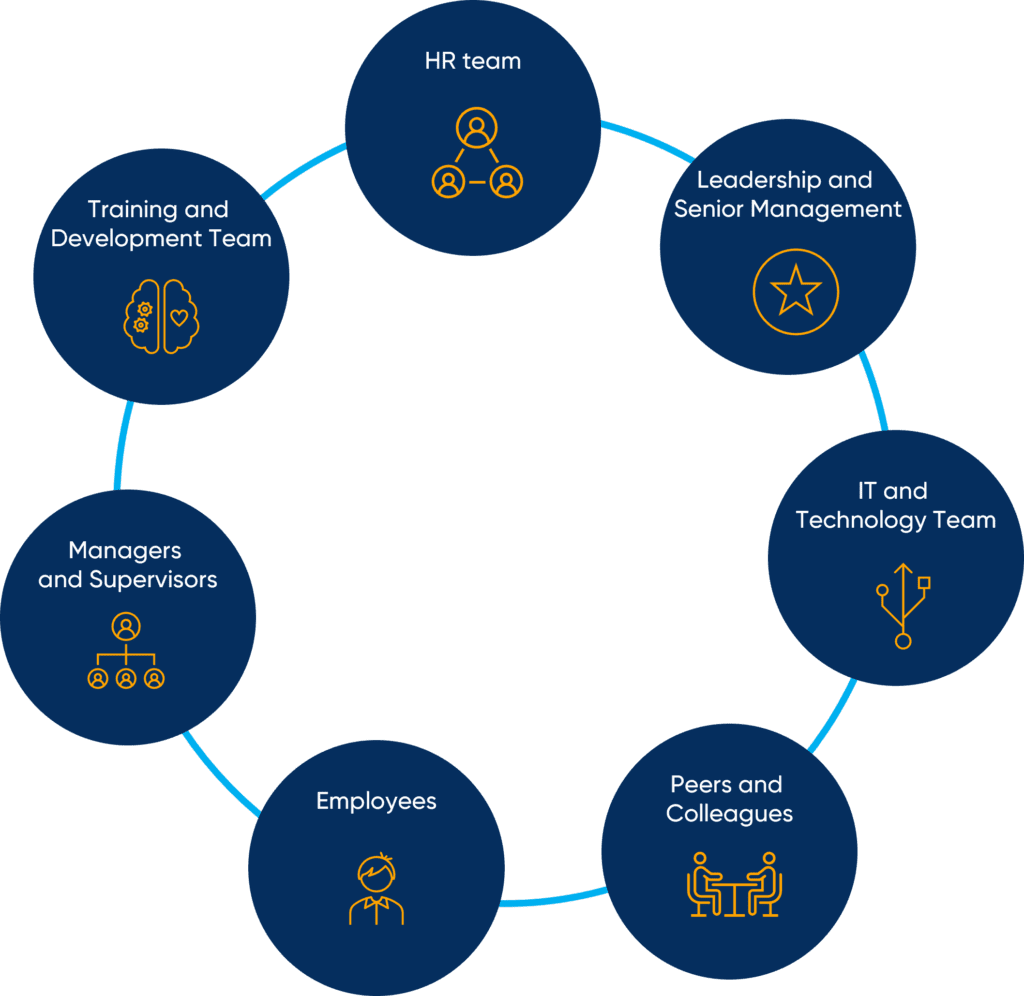If you’re not afraid of the extra scrutiny that comes with it, having highly engaged employees will benefit every part of your business. From improved productivity and staff retention, to more satisfied customers and shareholders. But, at the end of the day, who is responsible for employee engagement?
All too often employee engagement is given to HR. Perhaps this feels instinctive for many business leaders, after all engagement is about people, and HR are the ‘people-people’ right? But in practice employee engagement is a much more holistic affair.
Who owns employee engagement
Employee engagement affects every part of an organisation. But who’s actually responsible for creating a workplace culture with highly engaged employees? Is it senior leadership? After all, the senior team has unparalleled ability to affect organisational change from the top down. But there can still be a divide between the culture a senior leader strives for, and the culture their employees embody.
So, perhaps it’s HR – many people would say so.
Human Resources typically work behind the scenes to define and implement policies and handle large-scale workplace challenges. So, in the discussion of who is responsible for employee engagement, it’s easy to pawn it off on them. Whenever a policy needs implementing, like a new system of feedback or new benefits packages, it’s down to HR to establish practical frameworks for them.
But some workplace cultures have a divide between HR and employees. A 2018 survey found that over 70% of employees in large tech companies are distrustful of HR. This, combined with how hidden they can be, means they also can’t lead by example like managers and CEOs do.
It takes a village to improve employee engagement
To build a workplace culture where employees have the opportunity to become engaged, several key stakeholders need to pull together.
Like senior leaders, managers can lead by example. The amount of time they spend with their teams gives them direct insight into the issues their team deals with on a daily basis. But a manager’s influence doesn’t usually extend far past their team, or past their level of seniority. While managers might know what needs to be done, they don’t have the ability to affect broad change across the whole organisation.
So, who is responsible for employee engagement?
The simplest answer is that we all are, from the company’s founder and CEO, right down to their most junior employee. But there are a few standouts…
Who owns what when it comes to improving employee engagement?
Just because engagement is on everyone’s shoulders doesn’t mean that we all contribute in the same way. A well oiled machine needs a variety of different parts, so it’s important for people on different levels of the business to push for engagement in the ways only they can.
There are 7 key groups of people who are responsible for a successful employee engagement strategy.
- HR Team
- Leadership and Senior Management
- IT and Technology Team
- Peers and Colleagues
- Employees
- Managers and Supervisors
- Training and Development Team

1. HR Team
The People Team is the conductor. HR leaders are the ones who are responsible for the overarching employee engagement strategy. They own engagement initiatives, ensuring everything runs smoothly, and ironing out hiccups. But they need to work alongside IT to pick the right tools for employees, and provide solid answers to any questions.
It’s down to HR to reciprocate the support given to them by senior leaders and managers advocating for engagement. But it’s also their responsibility to hold people accountable, whether they’re a manager or an employee.
Employee engagement responsibilities
- Shape initiatives and processes for engagement.
- Hold managers and employees accountable for any engagement programmes.
- Choose the right engagement tools and train managers in how to use them.
- Be the go-to source for information and support on all queries.
- Support managers and leaders with advice and updates.
2. Leadership and Senior Management
Organisational leaders need to be employee engagement advocates. They are the most powerful influencers of a company’s culture, and their attitude toward engagement trickles down and influences every part of the business. Their example sets the tone for everyone else – if leaders prioritize engagement, the rest of the organisation will follow suit.
As your company’s most powerful influencers, it’s essential that your CEO or board of directors are serious about their responsibility for supporting employee engagement. Engagement champions must craft a long-term vision for engagement, while supporting HR’s policy roll-outs. They’re also responsible for communicating and providing updates across the business.
Employee engagement responsibilities
- Demonstrate an enthusiastic attitude towards engagement.
- Craft the long-term vision for employee engagement strategies.
- Communicate changes in strategy.
- Support HR in roll-outs and ongoing performance measurement
3. IT and Technology Team
IT is often the hidden gatekeeper of a successful employee engagement strategy. Technology plays an important part in employee engagement. It’s essential then as the custodians of tech, that your IT team is involved from the start.
HR leaders need to involve IT in these decisions early on, as they’re the ones who will be conducting installations and specialized training. They’re the ones most likely to know about compatibility issues or other problems that might send you back to the drawing board.
Employee engagement responsibilities
- Help source and examine any potential employee engagement software solutions.
- Ensure the appropriateness and security of any new software.
- Assist in the roll-out of software to maximize capacity in as short a time-frame as possible.
- Support training activities where required.
4. Peers and Colleagues
In some organisations, peers and colleagues contribute to the performance management process by providing feedback and input on an individual’s performance. This 360-degree feedback can offer a well-rounded perspective.
While this group could never be seen as responsible for owning performance management, they can play a role in its improvement with honest and constructive feedback.
Employee engagement responsibilities
- Provide feedback and input on an individual’s performance when requested.
- Participate in 360-degree feedback.
5. Employees
The main responsibilities of employees in engagement-centric workplace cultures are to understand why these policies are being implemented, to provide feedback on what is or isn’t working, and to seek out opportunities for career development or personal growth. They should also regularly share progress and experience updates with their manager to provide data for HR.
Employees need to understand why initiatives are put in place and how those initiatives will benefit them. Employees need to be encouraged to share ideas and thoughts without fear of repercussion or being ignored.
Employee engagement responsibilities
- Provide feedback about what is and isn’t working with the current engagement strategy.
- Share solutions to improve the employee experience.
- Seek out development opportunities and learning experiences to facilitate personal growth. Provide updates on personal goals, successes and challenge
6. Managers and Supervisors
Employee engagement plans live and die by the actions (or inactions) of managers. As the day-to-day touch-point for employees, managers are responsible for implementing the engagement initiatives determined by leadership and HR. They are crucial in any employee feedback activity.
Without exaggeration, managers can make or break employee engagement. They account for 70% variance in engagement statistics. Managers are responsible for setting goals and motivating employees to reach them. They should frequently exchange open and honest feedback with their staff, which requires a high level of trust. Beyond feedback, managers should take the time to recognize employee contributions and achievements, while identifying employees who show enough promise to be promoted.
Employee engagement responsibilities
- Develop strong, trusting relationships with each team member.
- Give and encourage open, honest, appropriate feedback.
- Recognize and celebrate individual and team performance.
- Work with employees to create and track impactful goals.
- Identify promising individuals ready for new opportunities.
7. Training and Development Team
Teams responsible for employee training and development collaborate with managers to identify skill gaps and provide resources for enhancing performance. They play a role in aligning performance management with learning initiatives.
Employee engagement responsibilities
- Shape initiatives and processes for training and development.
- Collaborate with managers to identify skill gaps.
- Choose the right L&D tools and train employees on how to use them.
Employee engagement priorities for your business
So, with the issue of who is responsible for employee engagement out of the way, it’s time to talk about the practical methods for improving engagement across the whole organisation.
- Continuous feedback: Anonymous engagement surveys and annual performance reviews are seriously outdated. If you want anything more than a snapshot in time, you need ongoing feedback processes like an employee check-in. Ongoing feedback ensures HR can track changes over time, and that issues don’t get swept under the rug.
- Employee recognition: To be engaged, employees need to feel valued beyond just getting their paycheck. Recognition from a manager is better for long-term engagement than performance-based incentives, but it’s important not to overlook peer recognition, as according to SHRM, it’s actually more effective than managerial praise.
- More effective goal tracking: Employees tend to be the most engaged when they’re able to approach work in their own way. Using a modern goal setting system like SMART Goals or OKRs enables you to take a more results focused approach, while making it clearer than ever how employee contributions add up to business success.
- Better 1:1 conversations: Annual performance reviews may be dead, but that doesn’t mean employees don’t want to sit down with their boss. 1:1s enable you to have personal, private discussions about anything from employee well-being to goals for personal improvement. Much like recognition, direct 1:1s add a vital human element that helps engagement.










